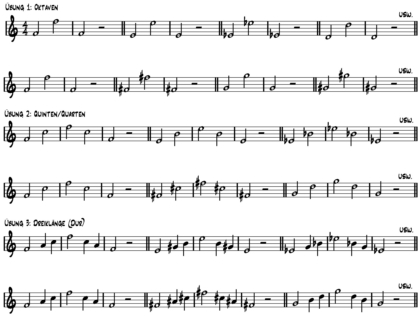Intonation for sax players
"Separating the wheat from the chaff" - the saxophone sound
Welcome to our workshop for sax players and saxophone sections. In this article, I would like to tackle a rather important subject likely to help you improve both your own saxophone sound and that of a saxophone section in a brass ensemble or big band: tuning (or intonation).For some reason, this subject is hardly covered in sax classes or orchestras. I’m sure, some sax players are not entirely happy about their sound. The good news is that this is not really a question of sound"”more often than not, your saxophone is simply out of tune. Coming to think of it: when we say an instrument is "flat" or "sharp", most of us think of its tuning, even though these terms also say something about the sound.This may become a problem in an ensemble or saxophone section, especially when one sax sounds "flat" and the next "sharp", thereby making it rather difficult to achieve perfect harmony"”and ruining the orchestra’s or band’s overall sound.
Intonation challenges saxophone
Saxophone players invariably have to compensate for minor intonation deficiencies of their instrument. Let’s have a look at the most likely notes and ranges:
- On most saxophones, the E (sometimes also the F) in the second octave is somewhat sharp.
- The C# below is often flat.
- The complete upper register is often sharp (starting from the A2, and especially the D3), while the entire lower register (from the D1 onwards) is flat.
This list is also useful, because it allows me to pinpoint a typical and usually dreadful mistake: while playing in the low register, some sax players think "oops, my sax is flat," and then tune it higher using the mouthpiece, only to notice a little later that their instrument is seriously sharp in the high register.
Obviously, not all tuning problems should be blamed on the instrument: some issues are "home made". If your breathing technique is rudimentary, with little or no "diaphragm support", playing notes in the high register often causes you to put too much pressure on your lips and your jaws"”and so your tuning is hopelessly sharp. Consequently, intonation has a lot to do with breathing technique and a controlled attack.
Simple rule-of-thumb: the more pressure you exert on your lips (and jaw), the higher the notes become, while releasing the lips lowers the tuning.
Intonation exercises saxophone
Acceptable tuning is also a matter of listening. If you listen to yourself and pay attention to your tuning, you are bound to notice deviations, and you will probably try to correct them automatically. I would therefore like to encourage you to listen to yourself while playing the following exercises. Play a few note sequences that allow you to check your tuning, like fourth steps (good old ambulance siren), fifths, octaves and triads (chords). Such intervals being easy to check, you will have little difficulty isolating your "weaknesses". Try to anticipate the notes you are about to play by trying to hear it in your head before actually playing it. Devoting as little as 5~10 minutes a day to these and similar intonation exercises should help you master your instrument in no time

Ensemble tuning
In saxophone sections, accurate listening is crucial for a convincing ensemble sound. Obviously, all saxophones need to be tuned before each rehearsal, using either a tuner or another instrument with stable tuning, like a piano or an electronic keyboard instrument.
Next, all members of the saxophone section should play the same note (e.g. the reference note for tuning). All sax players should furthermore pay attention to the overall sound produced by the section. Next, everybody plays the same note in a different octave to check whether the tuning is still OK. Alternatively, the tenor saxes can stay in the lower register, while the altos play one octave up. In this configuration, the alto saxes may sound slightly sharp, while the tenors are a wee bit flat. In any case, all sax players need to pay attention to the section’s homogeneity.
The next step could be to try a few triads and chords, like the final chords or a few slow passages from an orchestral work. And again, each and every sax player should listen to the section’s overall sound.
"Weather forecast" - Playing the saxophone at any temperature
Despite all this, there may be yet another problem: the tuning also depends on the ambient temperature!
In some cases, this may be so extreme that matching the saxophones’ tuning before the gig is insufficient. After all, after warming up (especially the instrument, that is), each instrument may indeed exhibit an altogether different tuning. Again, the only way to avoid such pitfalls is to listen closely to the others.One major challenge for brass bands and the like is that they often play outside"”irrespective of the ambient temperature. During a gig at a Christmas fair, your sax may be so flat that you need to push the mouthpiece as far as possible onto the cork, while still not achieving a perfect result. I myself still remember extremely high temperatures during a Circus Roncalli tour. On some days in the summer, the temperature on the band stage rose to 54°C, and my mouthpiece only just about dangled on the bocal"”and my sax was still way sharp.So, for what it’s worth: be sure to keep listening very carefully and to enjoy playing the saxophone.
Yours,


